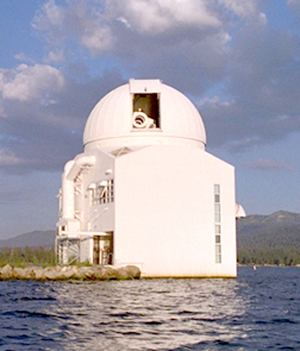Code G77 Established 1969 Opened 1969 | Altitude 2,060 m (6,760 ft) Website www.bbso.njit.edu Phone +1 909-866-5791 | |
 | ||
Address 40386 N Shore Ln, Big Bear, CA 92314, USA Similar Big Bear Lake, Moonridge Animal Park, Big Bear Discovery Center, Snow Summit, Aspen Glen Picnic Area | ||
Njit s big bear solar observatory
The Big Bear Solar Observatory (BBSO) is a solar observatory located on the north side of Big Bear Lake in the San Bernardino Mountains of southwestern San Bernardino County, California (USA), approximately 120 kilometers (75 mi) east of downtown Los Angeles. The telescopes and instruments at the observatory are designed and employed specifically for studying the activities and phenomena of our solar system's star, the Sun.
Contents
- Njit s big bear solar observatory
- Big bear originals the big bear solar observatory
- General information
- Instruments
- References
Big bear originals the big bear solar observatory
General information
The observatory was built by the California Institute of Technology in 1969 under the direction of professor Harold Zirin. Management of the observatory was transferred to the New Jersey Institute of Technology (NJIT) in 1997. Funding comes from NASA, the National Science Foundation, the United States Air Force, and other agencies.
The location at Big Bear Lake is optimal due to the clarity of the sky and the presence of a body of water. The lake surface is about 2,055 meters (6,742 ft) above sea level, putting it above a significant portion of the atmosphere. The main observatory building is in the open waters of the lake with an approximate 200 meter causeway extending south from the north shore. The water provides a cooling effect on the atmosphere surrounding the building and helps eliminate ground heat radiation waves that normally would cause optical aberrations.
When construction began in 1968, the water level of Big Bear Lake was significantly lower allowing land access to the construction site. The foundation was poured and completed just prior to the winter of 1968. In January and February 1969, three large storms caused intense flooding in central and southern California. The Los Angeles basin experienced the largest rain fall total for a two-month period since 1884. Big Bear Lake received over 70 inches of precipitation (almost 5 times the average precipitation). As a result of the flooding, the construction site was surrounded by water and the basement level of the observatory building was submerged. Barges were built to complete construction of the observatory and a causeway was constructed several years later to provide land access again.
Instruments
The observatory originally operated three solar telescopes: a 65 cm (26 in) vacuum reflector, a 24 cm (9.4 in) vacuum refractor, and a 20 cm (7.9 in) refractor. The 65 cm and 25 cm telescopes studied sunspots on the face of the Sun, while the 20 cm telescope tracked the full disk of the Sun from sunrise to sunset.
In 2006, the old main building dome was replaced with a larger, ventilated, 5/8 spherical dome in preparation for a new telescope. It is a scaled-down version of the Southern Astrophysical Research Telescope (SOAR) dome, and incorporates several strategies to improve astronomical seeing. Removal of the old 65 cm, and 25 cm telescopes took place in February 2007.
In early 2007, DFM Engineering began building a new 1.6 m (63 in) clear aperture open frame, off-axis Gregorian telescope. The New Solar Telescope (NST) saw first engineering light of the Sun at the Nasmyth focus in December 2008, and observations began in January 2009. The telescope is set on an equatorial mount, which is attached to the existing pier. The mirror was figured from a 1.7 m blank by the University of Arizona Mirror Lab as a proof-of-concept for the mirrors of the Giant Magellan Telescope. Until the Advanced Technology Solar Telescope is completed, the NST will be the largest clear aperture solar telescope in the world. It is able to resolve features on the Sun less than 50 km across. The project was a collaboration between BBSO/NJIT, the University of Hawaii Institute for Astronomy (UH IfA), and the Korea Astronomy and Space Science Institute (KASI).
In 2007, the 20 cm full-disk telescope was replaced by the 10 cm (3.9 in) Full Disk H-alpha (FDHA) Patrol Telescope, located in an additional small building called the Ash Dome. It is co-mounted with another small telescope dedicated to observing earthshine.
The observatory also hosts a station of the Global Oscillation Network Group, an experiment in helioseismology operated by the National Solar Observatory. It is located at the shore end of the causeway and began operating in 1995.
